
By:
- Inga Kiderra
Published Date
By:
- Inga Kiderra
Share This:
Studying Abroad Without Leaving Home
Field school in partnership with Kumeyaay takes students on a journey right in San Diego County
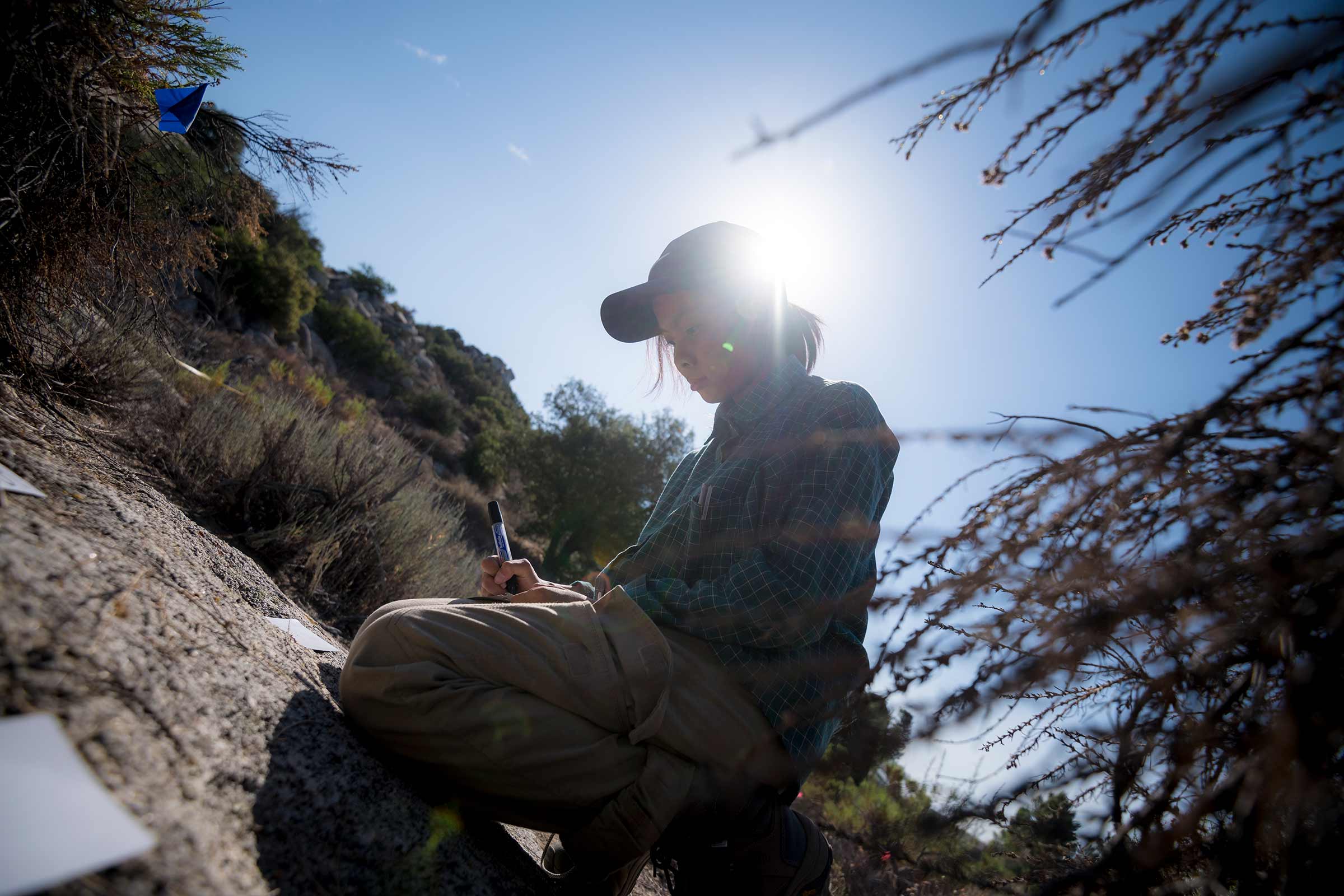
Photos by Erik Jepsen/UC San Diego Publications
There is writing on the land. Archaeologist Bobby Bolger places his hand on a granite boulder and pats. “Here,” he says. There isn’t any script where he’s touching. It’s a depression in the sunbaked stone made by years of grinding acorn or rabbit. He pats again. “Someone made this their life’s work,” he says, maybe 700 or 1,000 years ago. The stone, a bedrock mortar, sits in what is now a parched corner of eastern San Diego County, and Bolger is sure that it holds stories—on the land and in its people.
And in the summer of 2018, over five weeks in July and August, a group of UC San Diego students got to experience both kinds of accounts, learning directly from native Kumeyaay Indians and also learning from the land, as they gathered data on a prehistoric site at an ancestral Kumeyaay home on the La Posta Reservation.
Bolger, official tribal archaeologist for the La Posta Band of Mission Indians, is visibly moved by the bedrock mortar. Same goes for the bits of arrowheads and broken pottery scattered here, there, almost everywhere on the site.
‘There is knowledge here’
Standing on a hilly outcrop at the reservation, Interstate 8 shimmering in the heat on the horizon, he explained: “There is knowledge here that you can’t get anywhere else.” It’s what has been driving him, “the whitest of white guys” (as his tribal mentor likes to tease), to work with the Kumeyaay on understanding and preserving local Native American sites throughout the county. And it’s why he reached out with the idea of a field school to several academic archaeologists in town, including UC San Diego’s Paul Goldstein.
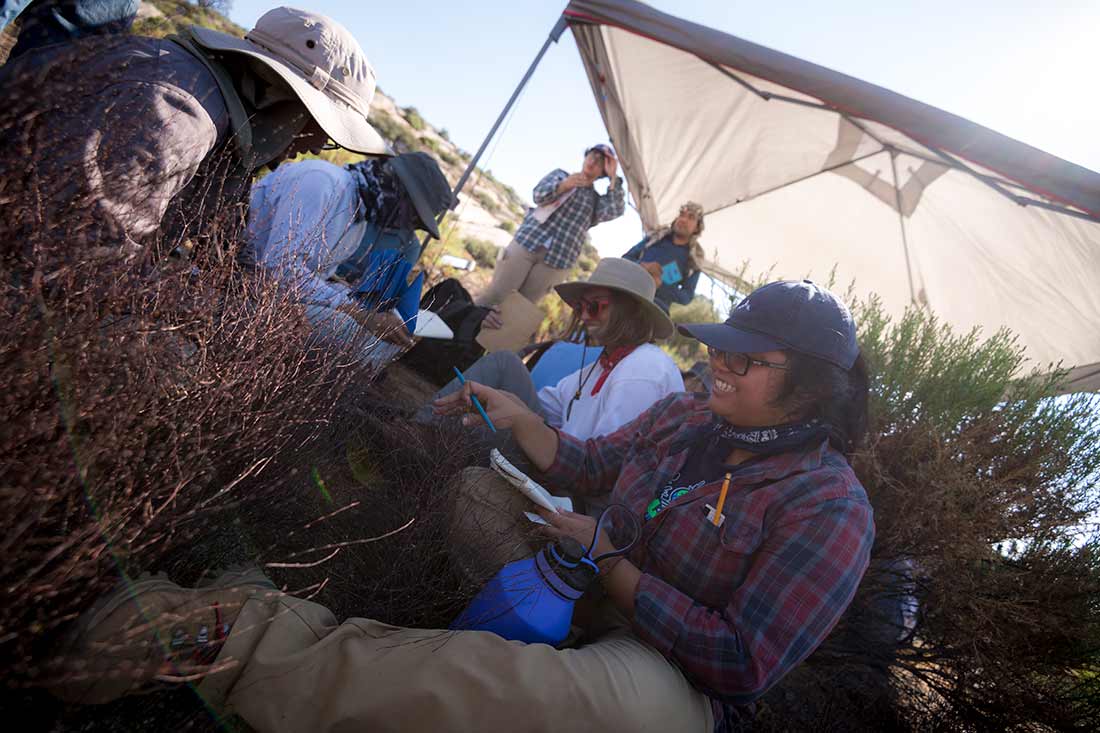
Eastern San Diego County is hot in July and August. Students take a break in the shade from surveying prehistoric artifacts on the reservation of the La Posta Band of Mission Indians.
Goldstein proved eager to partner with him. A professor in the Department of Anthropology at UC San Diego, Goldstein typically does research in South America. And, typically, UC San Diego students travel overseas for a field school in archaeology. Goldstein alone has led eight such excursions to Peru to date. But, Goldstein realized, not everyone can easily go abroad. There’s the cost of traveling itself, and there are also summer jobs to consider and family obligations. And international students—well, they’re already abroad. It was an intriguing opportunity, both to extend his field-school offerings and to work in partnership with the predominant local tribe.
The 2018 summer field school on the La Posta Reservation offered by the Department of Anthropology—a “study abroad” program on sovereign tribal land but just 70 miles from main campus and within commuting distance—drew 18 undergraduate students, more students than usually go with Goldstein to Peru.
Held in conjunction with the La Posta tribal council and monitored by members of the tribe, the field school surveyed a site that, in Goldstein’s words, is “almost completely unknown to academic archaeologists.”
In the space of five weeks, the team documented some 800 artifacts.
Each artifact was flagged where it lay, digitally photographed, and mapped. The mapping was done with both old-fashioned paper-and-pencil techniques and with GPS technologies and drone photography.
“The archaeology was entirely non-intrusive,” Goldstein said. “No excavation whatsoever—it was all surface mapping. We’ve come away with great data but left everything exactly as we found.”
The data are now being put together and analyzed. In the end, Goldstein and Bolger hope to have detailed maps of the site they can hand over to the tribe.
They also hope to publish some of their findings. “The dirty secret to archaeology,” Goldstein said, “is that it’s mostly paperwork. Most of the revelations happen in the lab.”
Clay pipe, quartz arrowhead
That isn’t to stay there are no excitements in the field. On the very first day, in the very first square cordoned off for survey, the team found a remnant of a clay pipe, with animal legs. “These are super rare,” Bolger said, noting that in 10 years of doing this work, he’s come across maybe three pipes in all.
They also found an arrowhead made of milky quartz. It is expertly crafted but probably too fancy and too delicate for use in hunting and may have been used ceremonially instead. Careful not to add any culturally incorrect or loaded labels, they are calling it simply a “Desert Side Notched Point.”
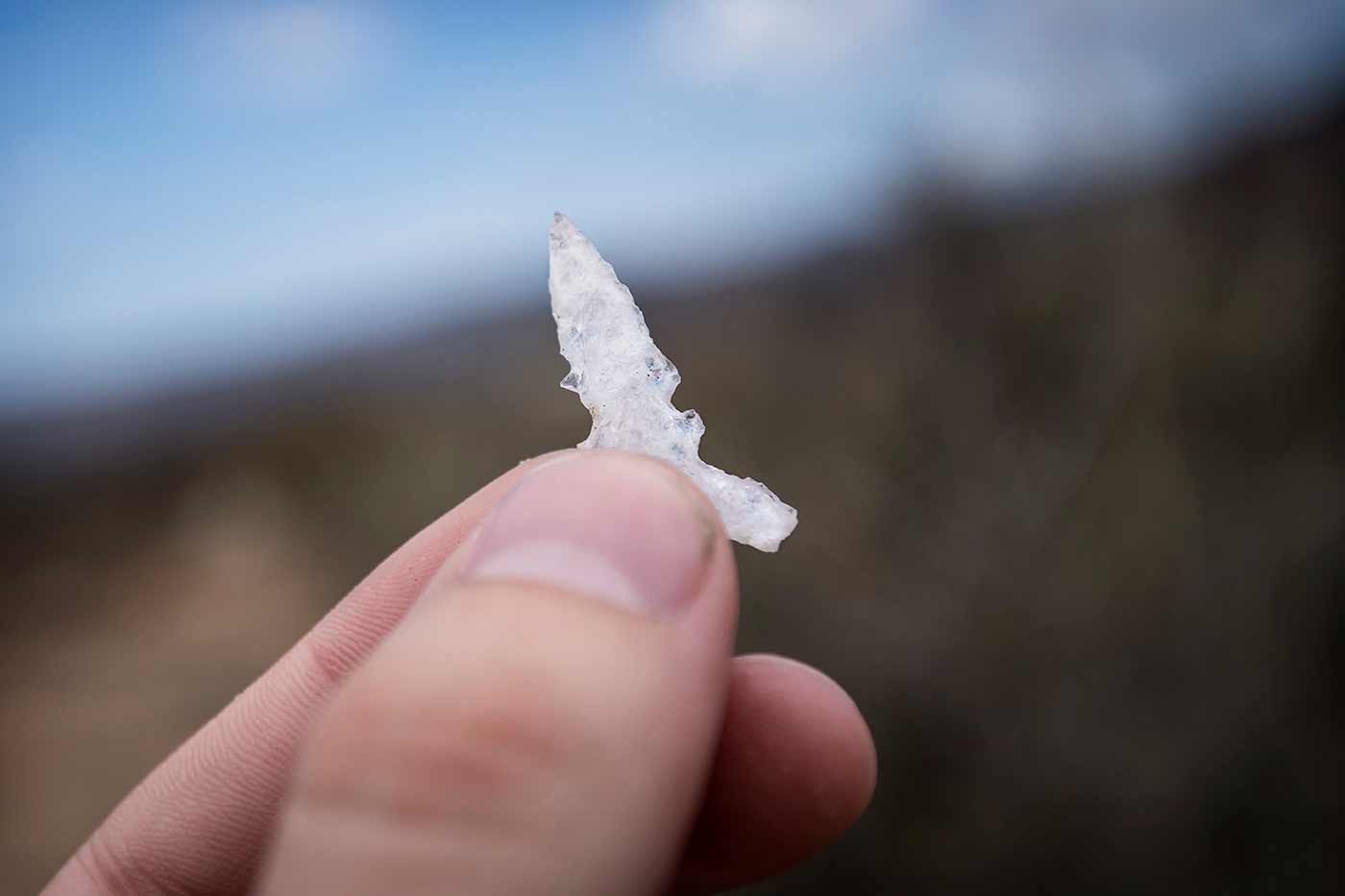
This arrowhead made of quartz may have been a ceremonial object rather than a hunting tool.
There are some obsidian arrowheads also, made of obsidian that comes from the south end of the Salton Sea, some 40 to 50 miles away as the crow flies.
Those are the standout artifacts, the ones that bring out the “oohs.” Most of the finds are sherds of everyday pottery in a style known as “Colorado Buff Ware,” Goldstein said, pointing to where mica has been added to the clay—and bits and flakes of stone tools. There are many, many of these. On just one morning, the field-school crew noted at least 68 different artifacts like that. The place bristled with small marker flags: red for ceramic fragments, blue for the stone bits.
The heat approached 100 degrees Fahrenheit. Red ants marched, mostly going about their own business. An occasional breeze blew. When it did, it was desert-hot but deeply welcome anyway.
Odd couple, perfectly matched
While Bolger piloted a drone and demonstrated how to land it safely in your hand, Goldstein sketched a pot sherd into his notebook and commented: “I like to bring in the analog component, to show how a compass works as well as GPS. When the field school is done, everyone should know how to get by when the batteries die.”
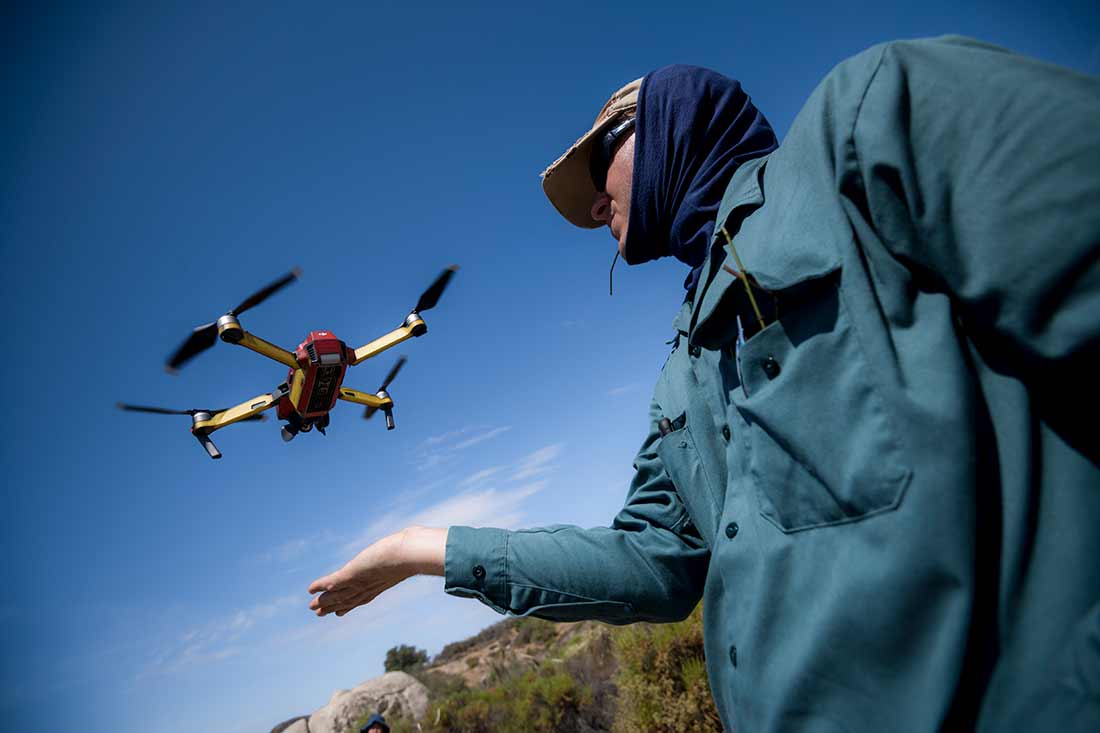
La Posta Tribal Archaeologist Bobby Bolger lands a drone in his hand – drones are revolutionizing field archaeology.
Goldstein and Bolger are a bit of an odd couple, perfectly matched. Goldstein likes to draw in the field. Bolger prefers newer technologies. Goldstein is a “ceramics guy,” while Bolger is better with “lithics,” or stone tools. The one is an academic of long standing, the other a seasoned practitioner in an area of archaeology called “cultural resource management,” or “CRM” for short. (CRM archaeologists hike through back country slated for power lines or new development, for example, or oversee construction sites, along with native monitors, watching for artifacts or remains that bulldozers might turn up.)
Together, Bolger and Goldstein gave the field-school students insights into different archaeological techniques and demonstrated, even when they didn’t talk about it explicitly, the different ways an archaeological career can go.
Kumeyaay elders and tribal members brought in another invaluable component: cultural context. Students heard from them about Kumeyaay history and traditions, and even got to try their hands at a little bit of traditional pottery-making.
‘Remembering the forgotten’
One student, a biological anthropology major named Tanya Piña, appreciated that the “community is very present here.” She especially enjoyed going to a tribal gathering, eating with the Kumeyaay, learning to sing native songs and play a traditional guessing game with coyote bones called peon.
At the field site, Piña remarked on how alive to the Kumeyaay their ancestors are. And she hopes, she said, that the field school can shed additional light on some of the ancient ways. “I like remembering the forgotten,” she said. “I like helping people to do that.”
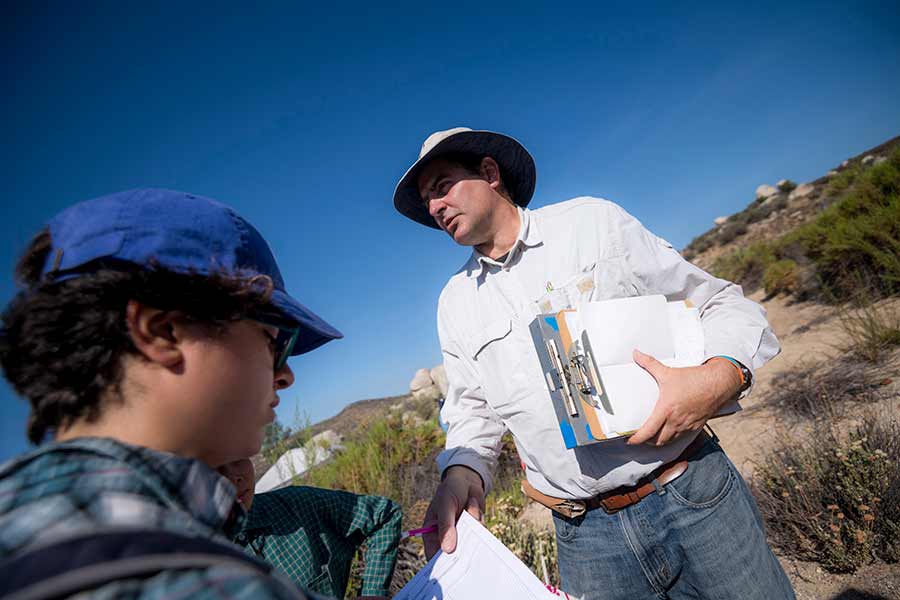
UC San Diego’s Paul Goldstein, at right, appreciates drones but says “marching around and mapping by hand” is also important, since it “forces you to think about the landscape.”
La Posta tribal member Richard Estrada served as one of the field school’s native monitors. He recalls visiting his grandmother at La Posta but has only been living on the reservation for the past 10 years or so—he’s still finding many new old things.
The site, Estrada said, was first noted as prehistoric by CRM archaeologists back in 1981. What they marked, though, was an “utter pinhole.” He and Bolger have worked to enlarge the pinhole in the years since. “But this group,” he said, referring to the field school, “is helping us realize how extensive the site really is.”
Even before the data are fully analyzed, Goldstein suspects it will show that Kumeyaay habitation here was greater than previously documented. There are just so many artifacts. Clearly, there were a fair number of people living here at one point, Goldstein said—making tools and breaking pots. Maybe a lot more than has been known. And how long ago? The story told by the ceramics on the reservation: Probably about 1,000 years, circa 1200 CE and as late as 1800.
There are other sites nearby, Bolger added, that appear to be as old as 10,000 years, or circa 8,000 BCE.
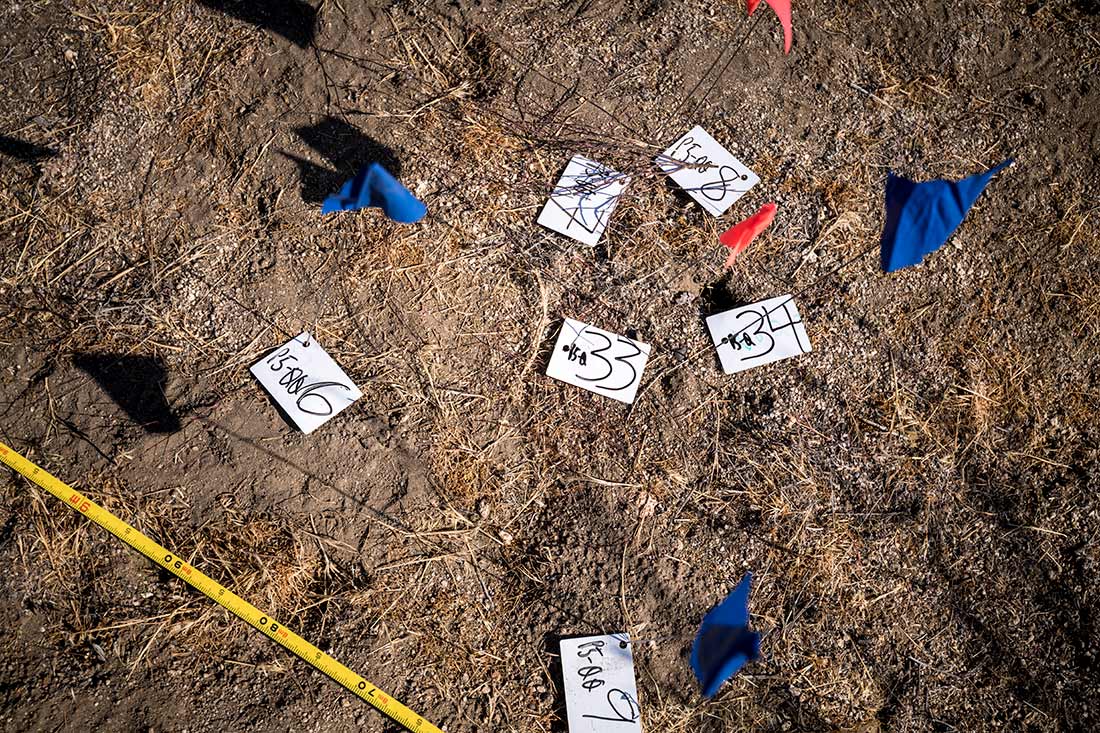
Red flags, blue flags mark where pieces of Kumeyaay pottery and stone tools lie. Number 34 is a flake of green metavolcanic rock.
“When we first got there, it was very impressive right away, the number of artifacts we could see,” said student David Moser, who, after retiring from the U.S. Navy, was finishing up his bachelor’s degree in archaeological anthropology with the summer field school. “But after a few days and weeks,” he said, “more and more continued to pop out.”
That’s not because the artifacts hadn’t been there all along, Moser said, but because the students learned over the course of the field school to see them. “The things that hadn’t been visible before became visible to us.”
Remember the boulder that Bolger was patting, the rock mortar? There is writing on the land, if you know where to look and how to read it.
Postscript: Moser has graduated and is considering trying his hand at CRM work. Another field-school student is starting an honor’s thesis on research begun at the reservation. Yet another is now doing an internship with the California State Parks, training as a monitor and doing lab analysis of native artifacts. Goldstein and Bolger hope to continue taking students to La Posta. For a future field school and to peruse some past ones, check out this page on the UC San Diego Department of Anthropology website.
Share This:
You May Also Like
Stay in the Know
Keep up with all the latest from UC San Diego. Subscribe to the newsletter today.


